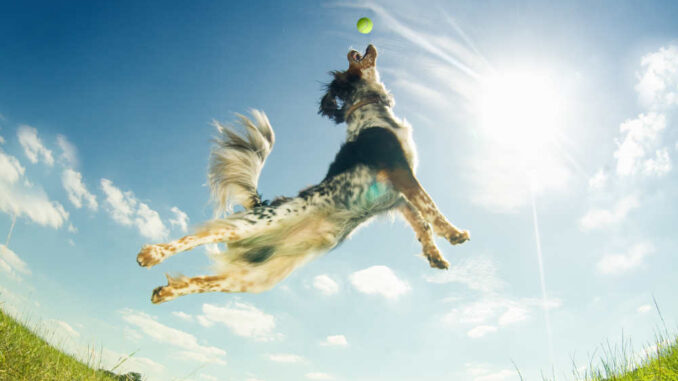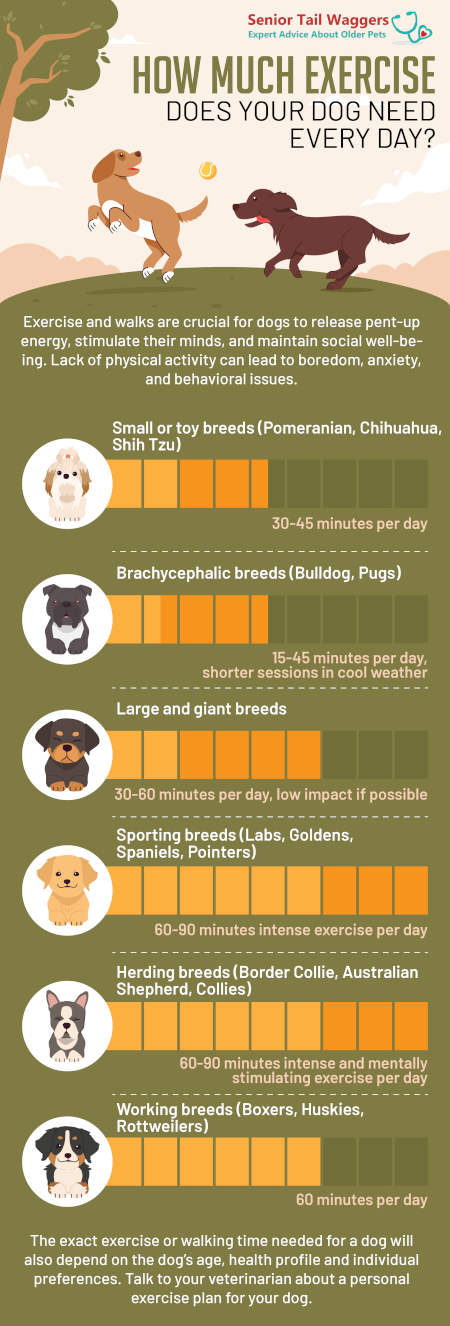
This article was updated on September 21st, 2023
Dog owners have a lot of questions about spaying or neutering their dog, and with good reason. It’s a surgery after all. Before more people are comfortable putting their pup through a surgery, they want to know risks, potential complications, recovery times, and maybe more commonly: will spaying or neutering help calm a hyperactive dog?! Let’s just say, the answer is complicated.
Do dogs calm down after being spayed or neutered?
Hyperactivity is a result of genetics (some dog breeds don’t come with an off button), and environment (dogs are more likely to be hyperactive if they don’t get enough exercise or mental stimulation1.
Studies are contradictory regarding whether spaying and neutering decrease hyperactivity, meaning it’s unclear whether the surgery will help this behavior.
A dog’s overexcitement and energy really have nothing to do with hormones, especially those of a reproductive nature. So, it would make sense that neutering or spaying a dog, which effectively removes fluctuation in those hormones, would NOT really play a role in your dog’s level of hyperactivity.
However, removing those reproductive hormones by spaying or neutering can have some other behavioral effects.
Behavioral effects of spaying or neutering
Sterilization can decrease sexual behaviors, such as:
- mounting,
- humping, or
- roaming.
Neutering can also decrease marking behavior, and this is likely regardless of dog age at neutering.
A major question is whether spaying or neutering can affect a dog’s aggression toward other dogs, and the answer is what we are not sure:
- Some studies suggest spaying/neutering is associated with an increased likelihood to resource guard and increased reactivity. Consistent with this, sterilized male dogs may become more skittish and fearful.
- A 2017 study found that neutered males are more likely to be checked out by other males while also being less comfortable with it, which is likely to increase fights. The same study also found that more intact males were aggressive toward dogs and humans, anxious, and hyperactive2.
- However, the data can be quite contradictory, and the studies are not well-controlled, so we can’t say for sure what effects sterilization has on these behaviors.
Neutering results in more behavioral improvements in male dogs
Most studies see more dramatic behavioral differences between intact and neutered males than in females following spaying. However, there may be some changes in your female as well.
Something else that you may see is weight gain in sterilized dogs. That’s because changing those sexual hormones can slow metabolism and increase appetite. It isn’t always a result of energy levels.
Keep in mind that these are all just generalizations. In reality, every dog is different, and the effects of neutering or spaying will be unique to your dog based on their age, sex, genetics, and learning history. In other words, don’t count on the surgery to work miracles nor to come without side effects.
4 effective ways to calm a hyperactive dog
Instead of relying on a surgery that more than likely won’t bring about the calm you’re looking for, try some of these tips instead, by Mindy Waite, Ph.D., CAAB, Certified Dog Trainer, and Dr. Chyrle Bonk, veterinarian at Senior Tail Waggers.
1. Stimulate the body
Look at your current daily physical and mental exercise regimen for your dog. Are you giving them enough? If you go for a short walk every day and your dog is still bouncing off the walls, the walk alone likely wasn’t enough. To help this, test out increasing their exercise and varying the type of activities in order to keep them on their toes. Your dog’s exercise needs and abilities will depend on their size, age, breed, and health status. For example, herding and working breeds typically require more stimulation per day, whereas brachycephalic breeds (e.g., bulldogs, pugs) may require less.
Instead of getting in one super long walk, think about breaking up the day into several walks or play sessions, which might be easier for you and more beneficial to your pup.
2. Stimulate the mind
Dogs need to work more than just their muscles in order to reduce their energy levels. Some breeds are especially prone to boredom and will turn their excess energy toward negative endeavors, such as chewing on your furniture.
One way of mentally stimulating your dog is through play, which can be dog-dog play, human-dog play, or solo play. Playing with your dog may include fetch, tug-of-war, keep away, chase, or running an obstacle course. All of these can help exercise their gray matter, muscles, and your animal-human bond.
Playing with your pup is wonderful but not always feasible. Feel free to mix in some interactive or puzzle dog toys, especially when you’re not at home. These toys often present a treat reward when a dog uses their cognitive skills to unlock it, and you can even use the dog’s meals instead of high-calorie treats. Some of my absolute favorite examples include:
- Our most versatile dog puzzle yet – this Level 2 Intermediate treat game is a great way to introduce puzzles to pets who have little to no experience while still providing an interactive challenge for smart dogs
- Happy Dog Promise: Our premium snuffle mat for dogs will keep your puppy calm & occupied, fulfilling your dog's natural desire to sniff. It can be used with your dog's normal dry food instead of a dog bowl, or as a small dog bed
Obedience and trick training have a place in stimulating a dog’s mind as well. Start with teaching your dog basic commands and then feel free to get creative with impressive tricks worthy of showing off at a party.
3. Let it happen
Of course, your dog should have manners. You don’t want them jumping up on people, knocking you over when they run by, or being otherwise obnoxious on a daily basis. But you also need to let your pup go wild on a daily basis. The key is to set times and places for both personalities to shine.
Consider making certain rooms or activities a time for manners, quietness, and calmness. Teach your dog to lie calmly on their bed or in their crate when needed, and be sure to reward them when they do so.
Other locations can be designated as places for your dog to let it all out. Allow them to run and play, get zoomies, play chase, and throw toys around. Give them the chance to burn some energy any way they see fit just as long as it’s safe.
4. Check in with your veterinarian or dog trainer
If your dog’s activity levels change suddenly, be sure to check with your vet. Some health conditions can affect a dog’s energy level and should be checked out by a veterinary professional. You may also want to turn to your local force free behaviorist or trainer if you just can’t get a handle on your dog’s wildness with any of the above tips.
Working with both a vet and behaviorist/trainer together often produces the best results, as they can team up to discuss medical and behavioral reasons for sudden concerning changes.
Exercise guidelines by Dr. Chyrle Bonk

| Small or toy breeds (Pomeranian, Chihuahua, Shih Tzu) | 30-45 minutes per day |
| Brachycephalic breeds (Bulldog, Pugs) | 15-45 minutes per day, shorter sessions in cool weather |
| Large and giant breeds | 30-60 minutes per day, low impact if possible |
| Sporting breeds (Labs, Goldens, Spaniels, Pointers) | 60-90 minutes intense exercise per day |
| Herding breeds (Border Collie, Australian Shepherd, Collies) | 60-90 minutes intense and mentally stimulating exercise per day |
| Working breeds (Boxers, Huskies, Rottweilers) | 60 minutes per day |
How to handle spaying or neutering a hyperactive dog
Let’s bring this back to spaying and neutering. So, we’ve already discovered that sterilization will more than likely not calm your hyperactive dog the way you’re hoping, even though you may see some of the other behavior changes. So, this means you’ll have an overactive dog that needs to stay calm for 7-14 days post surgery in order to heal properly and avoid potentially serious mishaps.
How long is the recovery period after spaying or neutering?
Of course, spaying is a far more intensive surgery than neutering. It involves doing into the abdominal cavity, creating an incision in the body wall. Neutering, on the other hand, happens outside the body wall, but that doesn’t mean you can immediately turn your male dog loose after surgery.
Your vet will advise you to keep your dog quiet, even confined for 7-10 or up to 14 days after surgery (see our recovery timeline for spaying & recovery timeline for neutering). This is to allow the body wall and skin to heal completely before adding the extra pressures of running, jumping, and wrestling.
You may take your pup on leash walks for potty breaks and gradually increase walk times after the first week. Males may be allowed to increase exercise a little more quickly, but that’s for you and your vet to decide.
How to keep your dog calm during recovery
The first day or two may give you a false sense of hope. Because of the anesthesia, your dog may spend the first 24-48 hours a little groggy, and not want to walk or play much. This is completely normal, but be ready for day three. Keeping your dog in a crate or small room is your best option to keep your dog from overdoing it during recovery. Again, leash walks for potty breaks are great.
You just don’t want running, jumping, or hard playing. Feel free to spend time with your pup in confinement though. This is a great time for some obedience training, interactive toys, and grooming. Break up your visits so that your pup sees someone every couple of hours throughout the day, if possible.
Allow other pets to visit too, just be sure to supervise so that they don’t start playing or working at your dog’s incision.
Be sure to see your vet if you have any questions about your dog’s activity level during surgery recovery. Some very active dogs may even need prescription medications to take the energetic edge off for a few days while their body heals.
- https://vetericyn.com/blog/causes-of-hyperactivity-in-dogs/ [↩]
- Kaufmann, Carina & Forndran, Sarah & Stauber, Chantal & Woerner, Kathrin & Ganslosser, Udo. (2017). The Social Behaviour of Neutered Male Dogs Compared to Intact Dogs (Canis Lupus Familiaris): Video Analyses, Questionnaires and Case Studies. Veterinary Medicine – Open Journal. 2. 22-37. 10.17140/VMOJ-2-113 [↩]
Disclaimer: This website's content is not a substitute for veterinary care. Always consult with your veterinarian for healthcare decisions. Read More.






Be the first to comment